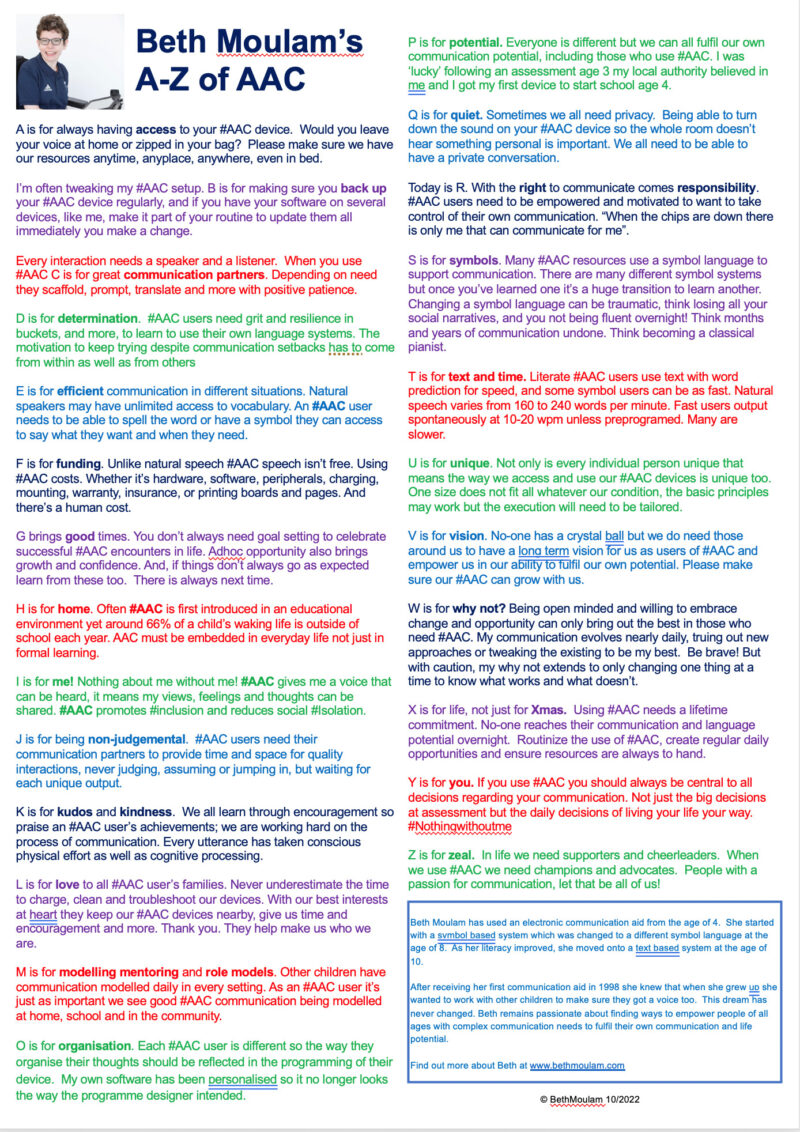 I’d been toying with the idea of an A to Z of AAC for months. Suddenly October seemed the right time to share my thoughts as it was international AAC awareness month. I’ve published every day on social media, mainly Twitter with what’s below, and with a bit more explanation on LinkedIn. Thank you to everyone who has read my posts, liked them, shared them and commented. I’m blown away by the feedback. So, by request, you can find below my full A to Z of AAC.
I’d been toying with the idea of an A to Z of AAC for months. Suddenly October seemed the right time to share my thoughts as it was international AAC awareness month. I’ve published every day on social media, mainly Twitter with what’s below, and with a bit more explanation on LinkedIn. Thank you to everyone who has read my posts, liked them, shared them and commented. I’m blown away by the feedback. So, by request, you can find below my full A to Z of AAC.
It’s important to note that this A to Z of AAC is personal, these are my thoughts, opinions and views based on my lived experience. They may not reflect the experiences of other AAC users.
A is for always having access to your AAC device
Would you leave your voice at home or zipped in your bag? Please make sure we have our resources anytime, anyplace, anywhere, even in bed.
B is for making sure you back up your AAC device regularly
I’m often tweaking my AAC setup. , so if like me, you have your software on several devices make it part of your routine to update them all immediately you make a change.
When you use AAC then C is for great communication partners
Every interaction needs a speaker and a listener. Depending on need communication partners scaffold, prompt, translate and more with positive patience.
D is for determination
AAC users need grit and resilience in buckets, and more, to learn to use their own language systems. The motivation to keep trying despite communication setbacks has to come from within as well as from others.
E is for efficient communication in different situations
Natural speakers may have unlimited access to vocabulary. An AAC user needs to be able to spell the word or have a symbol they can access to say what they want and when they need.
F is for funding
Unlike natural speech AAC speech isn’t free. Using AAC costs. Whether it’s hardware, software, peripherals, charging, mounting, warranty, insurance, or printing boards and pages. And there’s a human cost.
G brings good times
You don’t always need goal-setting to celebrate successful AAC encounters in life. Adhoc opportunity also brings growth and confidence. And, if things don’t always go as expected learn from these too. There is always next time.
H is for home
Often AAC is first introduced in an educational environment yet around 66% of a child’s life is outside of school each year. AAC must be embedded in everyday life not just in formal learning.
I is for me!
Nothing without me! AAC gives me a voice that can be heard, it means my views, feelings and thoughts can be shared. AAC promotes inclusion and reduces social isolation.
J is for being non-judgemental
AAC users need their communication partners to provide time and space for quality interactions, never judging, assuming or jumping in, but waiting for each unique output.
K is for kudos and kindness
We all learn through encouragement so praise an AAC user’s achievements; we are working hard on the process of communication. Every utterance has taken conscious physical effort as well as cognitive processing.
L is for love to all AAC user’s families
Never underestimate the time to charge, clean and troubleshoot our devices. With our best interests at heart they keep our AAC devices nearby, give us time and encouragement and more. Thank you. They help make us who we are.
M is for modelling mentoring and role models
Other children have communication modelled daily in every setting. As an AAC user it’s just as important we see good AAC communication being modelled at home, school and in the community.
N is for the nitty gritty of using AAC
To access their devices many people need additional kit. From mounting to input resources. Providing the kit is only the start, physical and environmental factors also impact each time we use it.
O is for organisation
Each AAC user is different so the way they organise their thoughts should be reflected in the programming of their device. My own software has been personalised so it no longer looks the way the programme designer intended.
P is for potential
Everyone is different but we can all fulfil our own communication potential, including those who use AAC. I was ‘lucky’ following an assessment age 3 my local authority believed in me and I got my first device to start school age 4.
Q is for quiet
Sometimes we all need privacy. Being able to turn down the sound on your AAC device so the whole room doesn’t hear something personal is important. We all need to be able to have a private conversation.
Today is R
With the right to communicate comes responsibility. #AAC users need to be empowered and motivated to want to take control of their own communication. “When the chips are down there is only me that can communicate for me”.
S is for symbols
Many AAC resources use a symbol language to support communication. There are many different symbol systems but once you’ve learned one it’s a huge transition to learn another. Changing a symbol language can be traumatics, think losing all your social narratives, and you not being fluent overnight! Think months and years of communication undone. Think becoming a classical pianist.
T is for text and time
Literate AAC users use text with word prediction for speed, and some symbol users can be as fast. Natural speech varies from 160 to 240 words per minute. Fast users output spontaneously at 10-20 wpm unless preprogrammed. Many are slower.
U is for unique
Not only is every individual person unique that means the way we access and use our AAC devices is unique too. One size does not fit all whatever our condition, the basic principles may work but the execution will need to be tailored.
V is for vision
No one has a crystal ball but we do need those around us to have a long-term vision for us as users of AAC and empower us in our ability to fulfil our own potential. Please make sure our AAC can grow with us.
W is for why not?
Being open-minded and willing to embrace change and opportunity can only bring out the best in those who need AAC. My communication evolves nearly daily, trying out new approaches or tweaking the existing to be my best. Be brave! But with caution, my why not extends to only changing one thing at a time to know what works and what doesn’t.
X is for life, not just for Xmas
Using AAC needs a lifetime commitment. No one reaches their communication and language potential overnight. Routinize the use of AAC, create regular daily opportunities and ensure resources are always to hand.
Y is for you
If you use AAC you should always be central to all decisions regarding your communication. Not just the big decisions at assessment but the daily decisions of living your life your way. #Nothingwithoutme
Z is for zeal
In life, we need supporters and cheerleaders. When we use AAC we need champions and advocates. People with a passion for communication, let that be us!
You can download the full version here which is a4 colour but can be scaled up to A0 poster size.
Full A-Z AAC colour v2 A4 scaleable
Some of the posts had links to my blogs and website articles, you can find them here: Communication Partners, AAC speech is not free, (Nitty Gritty of AAC) Direct Input, Using AAC at Home
International AAC Awareness Month was led by the International Society for Augmentative and Alternative Communication (ISAAC). The UK branch of ISAAC is Communication Matters.

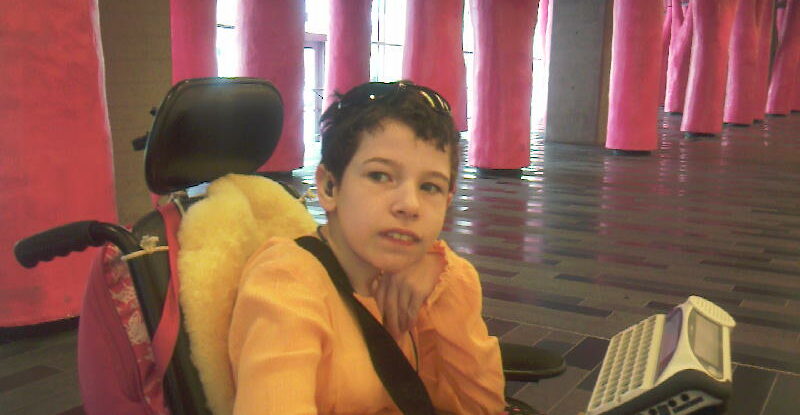
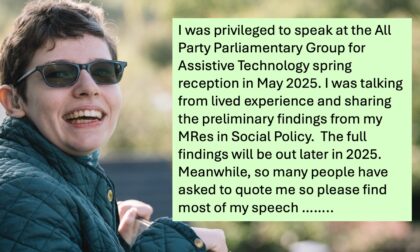
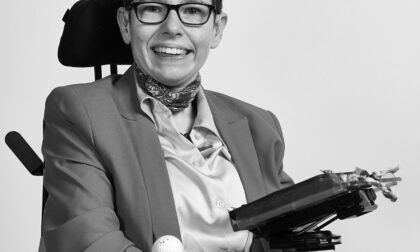
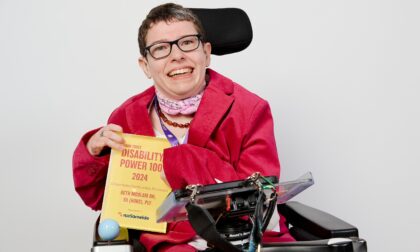
If you found this interesting or
helpful please feel free to share.